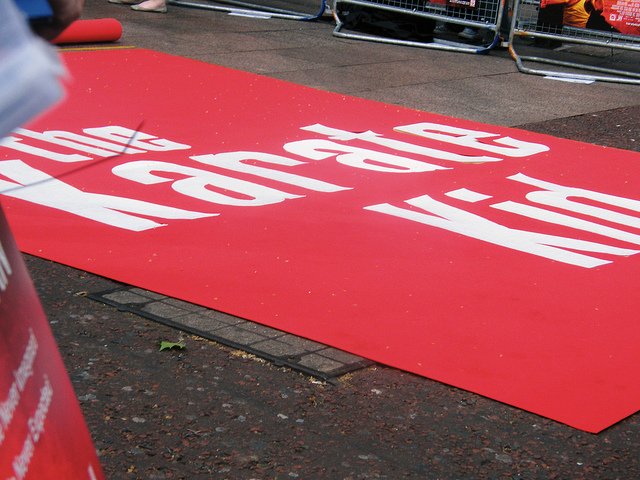Learning like Karate Kid
Our Style of Training: Expect Action Learning

“You know the movie about Karate Kid? Karate Kid learns a basic Karate move by putting up and hanging his jacket hundreds of times, desperately not understanding what this is for until a final physical insight helps him put the pieces together.” This quote from Udi Miron posted on our Ahaa wall at a recent #PoDojo training made us extremely happy as it reflects exactly what we want to achieve with our training style. The following post describes in more detail what this action learning training style is all about.
The Mission of the #PoDojo
With the #PoDojo we help people improve their skills in product discovery and delivery. People join the #PoDojo training will acquire new capabilities to help their stakeholders and teams create products and services with a better fit to the problems and needs of their customers.
Try this at work?
Similar to learning physical activities this practical skill set can only be learned by performing activities which involve not only the rational thinking part of your brain, but your intuitive, emotional and social concerns. For these activities, e.g. leading a user story writing workshop, interviewing a customer or pitching an idea, you need a context involving people, and the most realistic one is probably your workplace. Thus the most efficient way of learning may be to do some self-study and then try things out at work. Yet this may be risky since it can harm your work relationships, you may hear your team say “Oh, yet another new tool, we haven’t recovered from your last experiment yet” or it may even have a negative impact on your product or service development.
Design of the #PoDojo Training
Working as a product -creator, -owner or -manager - you name it - one needs to be good at dealing with ideas on the one hand, e.g. finding new product features, measuring outcome of what you deliver and making choices of what to build. And on the other hand one needs to be good at dealing with people, e.g. your team, the stakeholders of your product and the customers.
Thus besides subject matter expertise of the domain you are working in, being good at your job in product requires a wide range of practical skills unlike theoretical knowledge. We value theoretical knowledge like complexity science, queueing theory or neuroscience a lot. Yet first we find theoretical knowledge relatively easy to acquire, there are fantastic books to read, videos on youtube to watch, blogs to read. And second its usefulness is limited: it helps to make sense and to provide domain knowledge but it does not let you act more intelligently within the dynamic context of knowledge work.Thus we have designed the #PoDojo training to create a safe environment for playing with agile games and simulations that aim to provide a similar experience as trying it out at your job. These playful activities have to be challenging to inspire change of the known routines of thinking and behaviour just like a Yoga stretch to enlarge the mental landscape of the body. We follow a pattern of first applying the concepts and frameworks from the field of product development and discovery in a creative challenge. This creates some tension, awareness, along with a desire to learn. Next we spend time reflecting on the outcome, and finally sharing observations towards the way to achieving what is desired.That’s not the end of the learning experience since on day three, that we call the Product Launchpad, participants apply what they have learned in the exercises to their own real world challenges, e.g. a new product idea they want to work on. And we know of many, who joined the #PoDojo and completed the learning cycle by applying changes to their work later or by continuing to finally build the product.
Get into action learning mode
Here are some hints for attendees to get the most out of the #PoDojo training:
Don’t be afraid of making any failure or mistake, the more you try out during the three days, the more chances you have to learn. We have a pivot place to burn a candle stick for any failed idea.
Rather, get moving instead of being paralyzed by complexity and chaotic group dynamics. Take it as an opportunity to learn how to deal with self organisation and team based decision making. We do our best in leading the way thru the #PoDojo where group dynamics are an essential part of the learning.
Reflect on your desired outcome, keep your own learning goal in mind and adapt it as you go to what you have learned so far. We have regular reflection time in our Ahaa post-up sessions included.
Set your own pace. You may pass on activities anywhere, and there are opportunities to redo exercises.
Expect different levels of expertise in the group and diversity. We encourage co-learning since the best way of learning is teaching. So don’t be afraid to ask for help since you may provide a great learning opportunity for someone else who has experiences to learn while teaching on the #PoDojo.
References
Liz Keogh, Capabilities and Learning Outcomes
Dreyfus model of skill acquisition in Wikipedia
Sharon Bowman, “The Science Behind How We Learn New Skills” by LifeHacker
Tailor your presentation to fit the culture by Harvard Business Review
Photo Credits: fluterirl via flickr Creative Commons

